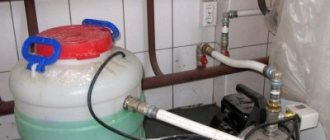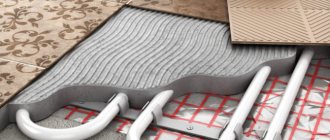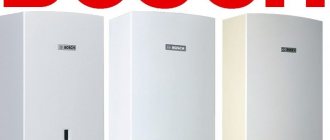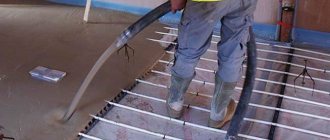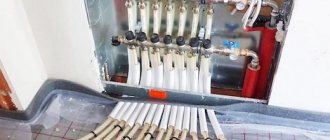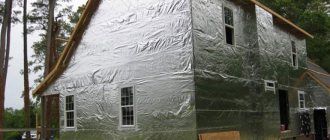Pros and cons of the product
It has the following properties:
- The operating temperature difference ranges from -30 to +106 degrees;
- The working life of the fluid is about 5 years;
- Safe for flax , paronite, rubber, plastic and metal-plastic, eliminating possible leaks;
- Safe substance for humans and animals;
- If the coolant is used only for heating , then its service life increases to 10 years;
- Explosion- and fireproof liquid.
Among the shortcomings it is worth mentioning the following:
- Inability to use electrolysis colas when heating a room;
- The presence of salt in the composition increases corrosion;
- It is necessary to use a composition designed for one of the operating temperatures. The use of a coolant with unsuitable temperature characteristics increases the possibility of glycol deposits forming, which threatens the failure of heating elements and the appearance of resinous deposits;
- Dilution of the “Warm House” composition with other liquids without testing may cause decomposition of additives and reduce the ability of the composition to resist corrosion.
Characteristics and types of coolant
The following brands of coolant are produced:
- “Warm House ECO-20” is an antifreeze made from propylene glycol. Ideal for dual-circuit heating devices;
- “Warm House -30” is an antifreeze made from ethylene glycol, used for heating with single-circuit boilers, but it is also suitable for other designs. When filling systems of double-circuit and tensile boilers, dilution is required;
- “Warm House ECO-30” is made from propylene glycol. When filling systems of double-circuit and tensile boilers, dilution is required;
- “Warm House -65” is a high-concentration composition made from ethylene glycol.
Features of antifreeze “Warm Home - ECO”
This fluid requires the use of glycol compatible sealants. It is allowed to use silky linen without oil paint. “Warm House - ECO” is not recommended to be mixed with antifreeze of other brands without first checking compatibility.
The shelf life of the proposed liquid is at least 5 years. It should be remembered that the durability of the coolant depends on a number of factors, including heating temperature. The composition should not be brought to a boil to avoid irreversible destruction of propylene glycol and the formation of additives. Intensive coolant circulation helps avoid overheating.
Antifreeze "Warm House - ECO" is safe for people and animals. This composition is approved for use as a refrigerant in the food industry. It is fire and explosion proof. In addition, the vapors generated when the refrigerant is heated are not toxic.
Application of compositions
The coolant of this brand is a liquid and is more fluid than water. For this reason, it is necessary to install the heating efficiently, after which the system must be pressure tested. Do not forget that it is prohibited to pour this liquid into electrolysis boilers.
Before use, most “Warm House” compositions are diluted with technical or distilled water. After dilution by 10%, its crystallization temperature increases to -25 degrees; if you dilute it to 20%, the characteristics of the solution will change to -20 degrees. After some time of operation, the coolant will begin to become jelly-like. If you dilute it with water at this time, the solution will restore its characteristics.
It is necessary to install the heating efficiently, after which the system must be pressure tested
Recipe for mixing 100 liters of coolant
“Warm Home” is often sold as a concentrate, which must be diluted before use. The proportions of the components affect the characteristics of the final solution (freezing point). If you add 23 liters of water to 77 liters of concentrate, the freezing point of the resulting solution will be about -40 degrees.
By dissolving 35 liters of water in 65 liters of concentrate, you will get a solution that can freeze only at -30 degrees. Adding 40 liters of water to 60 liters of concentrate will give you a mixture that will freeze at 25 degrees below zero. If the frost in your region is no more than 20 degrees, then you need to dilute 54 liters of concentrate with 46 liters of water.
For this reason, after the end of its useful life, the coolant must be drained and disposed of. Before filling the system with a new solution, be sure to check all components for leaks and completely flush the heating system.
After the end of its service life, the solution still freezes only at low temperatures, but its anti-corrosion properties are significantly deteriorated
Reviews
We use “Warm House” -65 for our heating. It is often counterfeited, but if you buy it from a trusted store, you can hope that it will serve well. Convinced by my own experience.
I pour this coolant into the heating myself. But my heating system is low temperature. The temperature is no more than 60 degrees (if it’s 20 outside). It works fine, for heating with temperatures up to 80 degrees, the additives will probably decompose. You must carefully read the certificates to determine the highest operating temperature it can be used. Please also note that heating elements are designed to work with water.
I purchased the “Warm House” composition - as soon as I filled the system with the pump, I immediately noticed that the gaskets were leaking. If you use water instead of coolant, then after it you need to tighten all the connections; it is a very fluid liquid. There are no complaints during operation; in winter, this mixture heated the house normally. When we left it for almost three weeks, it did not freeze.
Installed an imported heating system and foreign pipes and fittings. But there was no longer enough money to buy 200 liters of imported coolant, so I used “Warm House”. The boiler works great with it, there are no system leaks.
If you remember that new antifreeze needs to be added every 5-6 years, my decision to use this mixture will not surprise anyone - it is not very expensive and does not damage the heating system. True, there is a slight doubt whether its freezing temperature will be enough for the northern regions.
Rating of the best coolants
Having seen the key parameters for choosing a product, let’s move on to the rating of coolants based on the characteristics and user reviews. This will help you find out in advance the pros and cons of antifreeze for heating in a house, country house or enterprise, and choose the best one for specific operating conditions.
DIXIS-65
Rating: 4.9
A universal tool for working with gas and electric boilers of any type of installation. Optimally transfers heat at ambient temperatures from -65 to +95º C. Suitable for heating with pipes made of cast iron, copper, aluminum, brass. Does not damage solder joints or harm plastic pipes and containers. Along with the product, a sticker for the boiler is provided, which contains fields for recording the date of refueling, volume and other important details, which will be very useful years later when servicing the heating.
Our experts awarded this coolant first place in the ranking due to its high crystallization temperature of -66 degrees. This is the best product for heating systems in the Far North and other cold regions, which will withstand severe frosts and keep pipes and radiators intact. If used in areas where the winter temperature does not drop below -20º C, antifreeze can be diluted with water in a 1:1 ratio, which will significantly save money.
Advantages
- fireproof;
- the highest antifreeze rate;
- guaranteed service life 5 years;
- protection of the container from unauthorized opening.
Flaws
- heat capacity is 10% less than that of water;
- strong viscosity;
- not suitable for galvanized pipes;
- cannot be poured into boilers with an electrode operating principle.
Blitz tips
If you dilute the coolant with water from a well or well, which contains a lot of minerals, then it is advisable to dilute the mixture in a transparent container in order to notice the formation of sediment in time. Considering that in some regions the water is of very low quality, it is advisable in this case to use completely ready-made formulations.
Not recommended:
- Fill galvanized systems because sediment may form from the coolant as a result of a chemical reaction;
- Use the composition in heating with electrolysis boilers;
- Mixing “Warm House” with similar products may cause a decrease in performance properties and service life;
- Overheat the coolant.
The compositions “Warm House -30” and “Warm House -65” are produced only for technical purposes (it contains poisonous ethylene glycol). To prevent poisoning, this composition should not be allowed to get into drinking water or food. If it gets on the skin, the area must be washed well with soapy water.
"Warm House-ECO" is suitable as a refrigerant in food production. But this does not mean at all that, for example, you can drink it. All types of coolant are explosion-proof and do not support combustion.
If necessary, the coolant must be stored in an airtight container, inaccessible and protected from sunlight; they should not be placed near food products.
The coolant "Warm House - 65" is produced on the basis of domestic high-quality ethylene glycol (colored red). It is intended for various heating and air conditioning systems as a working fluid, ensuring operation in the range from – 65°C to 112°C (in accordance with the instructions for operating the equipment).
A specially selected package of additives reliably protects against scale, foaming and corrosion, does not have an aggressive effect on plastic and metal-plastic, rubber, paranit and flax, i.e. the possibility of leaks is excluded. As an exception, its use in systems with galvanized pipes is undesirable, because precipitation is possible. However, you should know that it has a slightly higher fluidity than water, so it is necessary to carefully assemble all the connecting units and be sure to carry out preliminary pressure testing of the system. If necessary, joints in systems can be treated with sealants resistant to glycol mixtures (Hermesil, ABRO, LOCTITE), and silky flax can be used without smearing with oil paint.
“Warm House - 65” cannot be used for electrolysis boilers (type “Galan”). The coolant for electrolysis boilers must have a certain electrical resistance, for which it is saturated with salts. But this worsens all other parameters for protection against corrosion and scale, so the developers of “Warm House” refused to create a joint universal recipe.
The coolant "Warm House - 65" is highly stable and ensures continuous operation for five years. To obtain the working mixture at the required temperature for the start of crystallization, the “Warm House - 65” coolant is diluted with distilled or ordinary tap water:
It should be taken into account that at the indicated temperatures the crystallization process is just beginning, and its thickening occurs when it is lowered by about 8°C. Destruction of the system is excluded, since the coolant does not expand.
It is imperative to dilute “Warm House -65” with water! This allows you to increase the heat capacity and reduce the viscosity of the coolant, i.e. improve its circulation. The optimal dilution of the coolant is -25° - -30°C, for electric and gas boilers - at -20°C. Using a mixture with a lower crystallization onset temperature can lead to ethylene glycol deposits on heating elements or in the burner area, which will lead to the formation of tarry deposits, burnout of heating elements, etc.
If water from wells, boreholes, etc., where there may be a high content of salts and metals, is used to dilute the coolant, it is recommended to first mix the coolant with water in the required proportion in a transparent container and make sure there is no sediment. Mixing the coolant with water can be done immediately before pouring into the system (especially for systems with natural circulation) or by filling it alternately in small portions.
Composition of the coolant "Warm Home - ECO"
The basis of antifreeze is pharmacological grade propylene glycol. This liquid is green in color and contains fluorescein, which makes it easier to find leaks. The coolant “Warm House - ECO” is designed for use as part of heating and air conditioning systems. The operating temperature of the fluid ranges from –30 to 106 °C. This makes it suitable for use in double-circuit boilers, as well as in facilities with high environmental safety requirements.
The coolant "Warm House - ECO" contains a package of additives that serve to protect against scale, foam formation, and corrosion. The manufacturer does not recommend using this composition in systems with galvanized pipes due to the likelihood of sediment formation. In addition, care must be taken to seal the system - this is due to the high fluidity of the composition. Before putting the circuit into operation, it is recommended to perform preliminary pressure testing.
Product range
| “Warm House - ECO” is a high-quality propylene glycol-based coolant, designed for use in single-circuit and double-circuit boilers. This composition is environmentally friendly and does not have a corrosive effect on brass, copper, steel, cast iron and aluminum alloys, as well as solder. The manufacturer allows the presented coolant to be diluted with water. | Price: 899 rub. Order |
| “Warm House - ECO” is an environmentally friendly coolant that contains propylene glycol. The product is designed for use in single-circuit and double-circuit boiler equipment. Like other coolants under the “Warm House” brand, the composition is safe for aluminum, copper, cast iron, steel and aluminum parts. | Price: 1750 rub. Order |
| “Warm House - ECO” is the optimal solution for single-circuit and double-circuit boilers. The presented coolant has high performance and is environmentally friendly. The propylene glycol contained in the composition is safe for most materials, including polymers and metals. The offered product is supplied in larger volume containers that can hold 50 liters of liquid. | Price: 4350 rub. Order |
Description
“Warm House” is a liquid that is a concentrated antifreeze produced using a combined package of anti-scale and other additives. All these ingredients are used to produce heating fluids that have a low crystallization temperature, that is, freezing.
Reducing the amount of ethylene glycol increases thermal conductivity and heat capacity, which lowers the freezing point. The viscosity of the solution is reduced, and this makes it possible to improve the circulation of coolant in the system, increasing heat transfer.
“Warm House” is a liquid that is best suited with its thermophysical properties for the climatic zone of central Russia. The best antifreezes are those that begin to crystallize at a temperature of -25°C. If we are talking about the described solution, then it freezes at lower temperatures.
Why you should choose antifreeze brand “Warm House”
For heating, “Warm House” can protect heating from destruction, which is ensured by the thermophysical characteristics of the composition, even if the system encounters an emergency stop problem. The pipes will not collapse, because the composition turns into a jelly-like state at lower temperatures.
If you use coolants with a high content of ethylene glycol, this can cause carbon deposits on the surface of the heating elements or in the burner area. Among other things, you may encounter the problem of the formation of tarry deposits, as well as overheating of the heating elements.
In order to obtain an aqueous solution with the required operating temperature, it is necessary to dilute the “Warm House” battery liquid with distilled water or water taken from the water supply system.
Heating system "Warm House"
The “Warm House” heating system allows you to create and automatically maintain a microclimate in each room. All modules are equipped with high-precision programming device, do not require grounding and are not sensitive to voltage drop. Possibility of programming from the central control panel or built-in cassettes will save energy consumption by 60-80%. Anti-freeze function in winter it will provide a temperature of +5-7°C, consuming virtually no energy. The power range from 500 to 2000 W allows you to optimally select heating modules for each specific room. Any owner can install “Warm Home” heating within a few hours. Heating costs for a “Warm House” are several times lower than any other heating method. Electric modules do not burn oxygen or dry the air, which has a beneficial effect on the health of people, animals and plants, and makes it possible to successfully use the “Warm House” heating system not only in country houses, but also in apartments with poorly functioning central heating, as well as when constructing winter gardens and greenhouses.In addition to heating, the “ Warm House ” technology involves the installation of equipment for the production of hot water (water heaters of various types and displacement). There are water heaters equipped with a ceramic heating element instead of a conventional heating element, heated towel rails for the bathroom and, if necessary, “warm floors”. All equipment is supplied by NOIROT, France.
The huge amount of information now presented by companies selling heat and other amenities can lead any owner into a dead end.
After all, he remembers that his grandfather and father used to heat a stove or a potbelly stove, then boilers using different types of fuel appeared, and some craftsmen made electric heaters, violating all imaginable and inconceivable rules and regulations. In order to get heat, you need to make a lot of effort and purchase many heating elements - radiators, a circulation pump, an expansion tank, pipes, shut-off valves, fittings, and most importantly a boiler.
Let's focus on electric heating, since it is the future . The global electric heating industry does not stand still. Many leading companies have moved away from producing electric boilers and are producing elements for direct electric heating. A distinctive feature of such heating is the selective heating of rooms in a building, as well as the possibility of prolonged operation of heating modules in the absence of a person, while maintaining the set temperature, fire and environmental safety. The only company that produces the entire range of equipment and has developed a patented new heating element is French (NOIRO).
Consider a heating convection module . The temperature regime in it is ensured by a built-in or remote thermostat (world leaders generally have a built-in thermostat), regulating heating in the range from 4 to 30C. Fire and environmental safety is ensured by high-tech heating elements, which are made of special materials, enclosed in ceramics and placed in a functional casing. Modern heating modules are made in a splash-proof version and can be used in damp rooms. Simple installation on any surface and connection can be performed by a person with basic skills . If there are several modules in the room, then it is possible to connect them to a central programming device. A number of control devices allow you to program the heating for several days, weeks and months, as well as control the heating by telephone.
The modules have various designs, which allows them to be used in rooms of any configuration.
It is necessary to pay attention to the model range of infrared emitters, both ceiling and wall mounted. They are the latest advancement in direct electric heating. IR emitters are designed to create thermal comfort in residential premises of any class, sports, repair and industrial premises. Solar thermal energy is a classic example of natural heat.
How does infrared radiation affect human health?
To answer this question, it is necessary to understand the physical nature of IR radiation. The wavelength and intensity of thermal radiation depend on the temperature of the heat source; the shorter the wave, the higher the temperature and intensity of the radiation. The surface temperature of the IR heater ranges from 100 to 800 C. For a living space with a ceiling height of 2.3 to 3.5 m, the temperature of the IR emitter should be 100-150 C. These are the most comfortable and safe settings. For rooms with a ceiling height of more than 4 meters, the temperature of the IR emitters should be at least 650-750C . This frequency spectrum is harmless to humans, as confirmed by independent tests and manufacturer certificates.
Compared to convection heating, where air is heated, circulating through the room and heating objects, IR emitters directly heat objects, and then the heat is transferred through the air. Studies have shown that when heated by radiators or heating modules, the temperature difference in height is 1.7-2.5 C/m. With IR emitters, the temperature at the floor surface is higher than at the ceiling, the temperature difference is 0.2-0.3 C/m. Under these conditions, the temperature at a height of 1.5 m can be lowered by 2-3 C without harm to humans, because the temperature near the floor will correspond to 18-19C.
Significant energy savings come from selective heating in zones or directly above a person’s place of rest or work . A distinctive property of IR emitters is the heating of walls, cavities, etc., which prevents the occurrence of dampness in the room and the appearance of mold.
Heating of winter gardens and greenhouses with IR emitters creates a natural microclimate for plants . All of the above advantages of direct electric heating show how effective the use of this heating is in cottage construction, warehouses, sports fields, hospitals, etc.
And most importantly, the costs of direct electric heating are 2-3 times lower than traditional ones. During operation, energy savings reach 40-60% compared to traditional ones, which use a boiler, pipes and coolant.
Laying laminate parquet.
Recipe for preparing 100 liters of solution from concentrated coolant
“Warm House” is a liquid that can be used to prepare a ready-made solution that is poured into the heating system. The proportions of ingredients will affect the temperature at which freezing or crystallization begins. Thus, if you add 77 liters of coolant to 23 liters of water, the freezing temperature will remain at -40°C.
By adding 65 liters of coolant to 35 liters of water, you will create a solution that will freeze at a temperature of -30°C.
Forty liters of water and 60 liters of coolant will produce a solution that will begin to crystallize at 25°C below zero. If the thermometer in your house does not drop below -20°C, then 54 liters of coolant will be enough for 46 liters of water.
Warm House liquid can be diluted with water from a well or a well, but it should be noted that in this case you may encounter an increased content of metals and salts. In order to avoid problems during operation of the heating system, a small volume of coolant should first be mixed with water. For this you need to use a transparent container. As a result, you should get a clear solution so that you can make sure there is no sediment. Such mixing can be carried out before filling into the system, which is especially true for schemes with natural circulation.
The described coolant is characterized by high stability of thermophysical properties, so it will be able to ensure continuous operation of the system for 5 years. After this period, the coolant will be a low-freezing liquid, but it can already be considered a solution that has exhausted the life of its additives, which is why you may experience scale build-up and corrosion. Therefore, the coolant is drained and disposed of. Before filling a new batch, the system is washed with water or a special liquid.
How to properly use heating with antifreeze
If it turns out that pouring antifreeze into the heating system of the house could not be avoided, then you need to know how to deal with it. This is a complex composition with many components. Both individual additives and their molecular bonds are created artificially in the laboratory. Of course, they were developed for use in high-temperature circuits, but there is a limit to everything.
Before you pour antifreeze into your home heating system, you should know that in order for the composition to have the characteristics specified by the manufacturer, it must be used for no more than the allotted period. Exactly as long as the integrity of the connections between the components of the composition remains stable. This period ranges from five to ten years for different liquids; more precisely, you can find out on the packaging.
Rules for using antifreeze:
- pour into clean pipes;
- do not allow too much heat;
- do not allow contact with galvanized pipes;
- avoid contact with air.
Before you pour antifreeze into the heating system of your home, you need to rinse it of all kinds of contaminants.
To do this, use different techniques:
- rinsing with water;
- chemical washing.
Both techniques are applicable in modern conditions. We have already written about how to flush the flushing fluid system. It is important that the flushing process is carried out until clean water flows from the circuit and all contaminants are removed. If this is not done, the antifreeze will not meet the stated characteristics. It’s like when painting pipes, when the quality of the protective coating largely depends on the preparatory work.
If antifreeze for heating a house boils (reviews indicate that this happens often), it can be drained and disposed of immediately afterward. A temperature of 95 degrees completely destroys the composition, it becomes extremely dangerous for all circuit elements. In addition to the fact that antifreeze itself is very caustic, overheating results in the release of acid, which aggravates the activity of the substance.
Additives precipitate. Antifreeze in the heating system of a private home begins to corrode pipes and tanks from the inside, rubber seals are especially susceptible to this. Even in working condition, antifreeze dries out the rubber. It then loses its elasticity and cracks, and when the composition becomes more aggressive, the process accelerates significantly.
If the lines are made of ferrous metal and are coated on the inside with a zinc compound, then the use of antifreeze in the heating system of a private home is prohibited. The fact is that upon contact with the protective coating of pipes, antifreeze produces a violent reaction, as a result of which a precipitate appears in the form of white flakes. It is clear that such a process destroys the structure of the antifreeze composition and, moreover, heavily pollutes the circuit. In addition, it also destroys zinc coating. As a result, both the pipes and the coolant are damaged.
You also need to pay attention to the fact that when antifreeze is cooled strongly, it becomes very viscous and its fluidity decreases. Therefore, when you start to heat the boiler after a long period of inactivity, during which the coolant has time to thicken, you need to do everything in moderation and gradually. To begin, set the heater to minimum to give the antifreeze time to warm up and become more liquid. The warmer it gets, the better the circulation will be. Gradually you need to bring the boiler operating mode to normal levels.
This approach is explained by antifreeze’s dislike of overheating. If you start firing the boiler immediately to the maximum, then the coolant that is in the boiler heat exchanger will overheat because there will be practically no circulation. The antifreeze will sit in one place for too long and will not have time to cool.
A lot of interesting things about stoves for heating cottages and their features.
Information that clearly describes autonomous gas heating of a country house, reviews and useful tips can be found here.
Dependence of coolant service life on operating conditions
Warm Home liquid will last longer if you provide it with appropriate operating conditions. Thus, experts do not recommend pouring liquid into a system that is equipped with galvanized pipes. This raises the possibility of galvanizing peeling off, and sediment may also form. In addition, the described coolant cannot be used in heating where there is an electrolysis boiler of the “Galan” type.
Heating fluid should not be mixed with other antifreezes, as this will cause reduced performance and possible damage to equipment. The coolant should not be brought to a boil during operation, since ethylene glycol and additives will be decomposed, and their thermophysical properties will certainly deteriorate, causing the coolant to last less than its intended life.
“Warm House” is a heating fluid that can be used exclusively for technical purposes, because ethylene glycol is toxic. In order to prevent poisoning, care must be taken to ensure that antifreeze does not get into drinking water and food products. If it gets on clothes or open areas of the body, you should wash them with soap and water. The coolant is explosion and fireproof, it has certificates of conformity and a conclusion on sanitary and epidemiological standards.
Additional properties of the coolant for the heating system
In order to ensure the necessary circulation of antifreeze in the system, it is necessary to supplement it with a more powerful circulation pump compared to what is used when working with water. Productivity and power should be increased by 15%, and pressure by 50%.
At negative temperatures in the system, heating of the coolant should be carried out gradually, while the power should increase in stages. Equipment should be sized and designed for thermal properties that differ from those suitable for water. This applies to air conditioning systems, etc.
“Warm House” is a heating fluid that has a higher coefficient of volumetric expansion when compared with water. Therefore, you should stock up on a larger volume. Before you start pouring new coolant into the system, you must check all connections and components, which is especially true when propylene glycol antifreeze was used.
How to properly dilute antifreeze for a heating system?
When pouring Dixis-65 concentrate, or another composition in the form of a concentrate, mix it with water only in a separate container. And only after that, fill the system with the already prepared, uniform mixture. Mixing antifreeze with water inside the system can unexpectedly make it difficult for the system to function properly. The result of improper mixing: - uneven heating of heating devices, and some devices do not heat at all due to the separation of water and antifreeze; — malfunctions of the circulation pump and even its failure; — foaming inside the system leads to its forced complete emptying, repeated flushing and refilling; - IN NO EVENT DO YOU STIR DIXIS-30, and especially DIXIS TOP, that are ALREADY READY for pouring. In this case, the foam will clog the system so much that it will be difficult to even rinse it again. When using expensive equipment, such things are generally unacceptable! If it’s already late and you poured liquid first and then water, DO NOT TURN THE CIRCULATION PUMP ON AT MAXIMUM speed (so that it mixes faster). Let everything remain as it is. Be patient. Periodically open the air vents on radiators. It takes time for everything to come together. In the case of gravitational systems (gravity flow), things are more complicated, and mixing takes much more time. That is why in almost all gravity systems we install a circulation pump through the bypass. Be patient and wait until it mixes. Dixis-65 concentrate is much cheaper in diluted form than Dixis-30 and even more so DIXIS TOP. But in practice, if your specialist has little experience, use only ready-made solutions offered by the manufacturer or contact us.
Antifreeze "DIXIS-65" is widely used in various systems - cooling, heating and air conditioning - not only in industrial but also in residential premises. The priority purpose of this antifreeze is to protect the system from so-called “defrosting” in low temperature conditions. In addition, DIXIS-65 antifreeze copes very well with the function of protecting equipment from corrosion processes and the onset of scale formation. A distinctive feature of DIXIS-65 antifreeze is the ability to use it both in its original and in a diluted state. In its original form, this coolant can be used in low-temperature climatic regions, for example, regions of the Far North. In a diluted state, DIXIS-65 can be used in regions with a temperate climate, where temperatures are not so low. By diluting this antifreeze with water in a ratio of 5:1, we obtain a coolant with a crystallization onset temperature of minus 40°C. Ratios of 2:1 and 1:1 make it possible to obtain antifreeze with an onset of crystallization equal to minus 30°C and minus 20°C, respectively. Antifreeze "DIXIS-65" is a homogeneous transparent liquid with a yellow-greenish color without mechanical impurities.
For reference
Non-freezing liquid “Warm House” is sold in containers. If necessary, you can buy antifreeze in plastic packaging, the volume of which is limited to 10, 20 and 50 liters. On request you can purchase a barrel with a volume of 216 liters.
Sometimes the mixture is shipped in bulk, in which case, as a rule, fuel tankers and cubes are used. If an order is made from 2 tons, then the coolant can be manufactured as a water-glycol mixture with a crystallization temperature at any level selected by the consumer.


